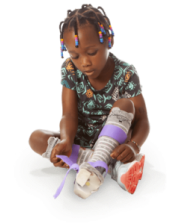What is a brachial plexus birth injury?
 A brachial plexus birth injury occurs when the nerves controlling movement and sensation in a baby’s shoulder, arm, and hand are damaged during childbirth.
A brachial plexus birth injury occurs when the nerves controlling movement and sensation in a baby’s shoulder, arm, and hand are damaged during childbirth.
Brachial plexus birth injuries typically happen during long or difficult deliveries. This is especially true if the baby is large and in a breech (feet- or buttocks-first) position.
In these situations, the brachial plexus nerves can be stretched, compressed, or even torn. This can result in weakness or paralysis in the affected arm.
The severity of these injuries can differ, and families may be able to take legal action if medical negligence is to blame.
Our trusted legal partner secured over $2 million for a North Carolina family whose child suffered a brachial plexus birth injury.
Cerebral Palsy Guide works with an extensive network of experienced birth injury lawyers who can help families in all 50 states.
The attorneys in our network have recovered over $962 million for preventable birth injuries.
If you suspect your child’s newborn brachial plexus injury could have been avoided, we may be able to connect you with a top birth injury lawyer near you.
Get a free case review right now.
Top 10 facts about brachial plexus birth injuries
Here are ten important facts to help explain the causes, symptoms, and treatment options for brachial plexus birth injuries.
- Newborn brachial plexus injury occurs in about 1 to 3 of every 1,000 births.
- The injury affects nerves controlling shoulder, arm, and hand movement.
- It’s more likely in difficult deliveries, including large baby size or breech birth.
- The condition is more likely when tools like forceps or vacuum extractors are used.
- Common signs include weakness or limited movement in one arm.
- Types of injury range from mild stretching to severe nerve tears.
- Erb’s palsy is a common brachial plexus birth injury.
- It is diagnosed through physical exams, sometimes with MRI or nerve tests.
- Treatment includes physical therapy and, in some cases, nerve surgery.
- Up to 90% of babies fully recover with proper treatment within the first year.
With prompt and proper diagnosis and treatment, most children with brachial plexus injuries show substantial improvement, providing hope for a full recovery.
Causes of brachial plexus birth injuries
Brachial plexus birth injuries can occur when a baby’s neck is tilted or stretched too forcefully during delivery. This movement can overstretch or tear the brachial plexus nerves, which start in the neck and extend through the shoulder, arm, and hand.
Medical negligence, such as improper handling of a difficult delivery, can contribute to birth injuries.
- Applies excessive force on the baby’s shoulders during a head-first delivery
- Mismanages shoulder dystocia (baby’s shoulders get stuck after the head delivers)
- Pulls the head and neck to one side as the shoulders pass through the birth canal
- Puts pressure on the baby’s raised arms during a breech delivery
When these nerves are damaged, they may not transmit signals properly, leading to weakness, loss of sensation, and even paralysis in the affected arm.
In severe cases, the nerves may be completely torn from the spinal cord, resulting in more severe complications.
Risk factors for newborn brachial plexus injury
Certain conditions related to the mother and baby make it more likely that neonatal brachial plexus palsy will occur.
These increase the likelihood of injury and may include delivering a large baby or maternal diabetes.
“One of the things we see with brachial plexus injuries is that we have moms who are diabetic and have large babies.”
— Andi Lowe, Cerebral Palsy Guide Registered Nurse
Doctors and health care providers should evaluate risk factors and take proactive steps to protect both mother and child.
Failure to properly manage risk factors for a brachial plexus birth injury can sometimes be considered medical negligence.
If your child’s injury was preventable, a birth injury lawyer may be able to help your family pursue compensation to support your child’s medical care and long-term needs.
Signs and symptoms of a brachial plexus birth injury
The signs and symptoms of a brachial plexus birth injury can vary depending on the type and extent of nerve damage.
- Appearing to have a loose-hanging or paralyzed arm
- Having limited movement in the upper or lower arm or hand
- Lacking a startle response (Moro reflex) on the affected side
- Exhibiting a weaker grip in the affected hand
- Holding the arm straight at the elbow and close to the body
These symptoms may be noticeable immediately after a child is born or develop soon after delivery.
Many newborns with a brachial plexus birth injury don’t experience pain. However, severe nerve damage may require further medical evaluation and care.
If your child is showing signs of a brachial plexus birth injury, you probably have questions.
Cerebral Palsy Guide has experienced labor and delivery nurses on staff who may be able to help.
Connect with a registered nurse — there’s no cost or obligation.
Types of brachial plexus birth injuries
Brachial plexus birth injuries can vary based on the specific nerves involved and the severity of the injury.
Neurapraxia, the mildest form, involves a stretched but intact nerve, often resulting in temporary weakness.
In more severe cases, a rupture can occur, where the nerve tears but remains attached to the spine, requiring nerve repair.
If a tear doesn’t heal properly, scar tissue can form, creating a neuroma that affects nerve function.
The most serious injury, avulsion, involves the nerve being torn from the spinal cord, potentially leading to permanent damage to the upper extremity.
Below are the main types of brachial plexus birth injuries.
Erb’s palsy
Erb’s palsy occurs when the upper part of the brachial plexus is injured. This type of injury often results in weakness or paralysis in the shoulder and bicep muscles.
Common symptoms include a limp arm, weak grip, and difficulty moving the shoulder. Treatment for Erb’s palsy involves physical therapy to prevent stiffness and maintain muscle function, starting as early as three weeks after birth.
Total plexus involvement
Total plexus involvement is a more severe injury that affects all five nerves of the brachial plexus. This often results in a complete loss of movement and sensation in the shoulder, arm, and hand.
Children with this injury may require extensive physical therapy, and in some cases, surgical interventions such as nerve grafts or transfers may be necessary to restore some function.
Horner’s syndrome
Horner’s syndrome is associated with an avulsion injury. This is when nerve roots are torn from the spinal cord, affecting the sympathetic nerves (which control functions like sweating and pupil size).
Symptoms of Horner’s syndrome include:
- Drooping eyelid (ptosis)
- Reduced sweating on one side of the face (anhidrosis)
- Smaller pupils in the eyes (miosis)
This condition is linked with severe brachial plexus injury and may require nerve surgery to address the damage.
Klumpke’s palsy
Klumpke’s palsy is a rare type of brachial plexus injury that affects the lower nerves of the brachial plexus.
This injury typically impacts the muscles of the hand, leading to weakness or paralysis in the hand and fingers.
Treatment may involve physical and occupational therapy to improve hand function, though severe cases might require surgery.
Diagnosing a brachial plexus birth injury in newborns
When a brachial plexus birth injury is suspected, doctors use a combination of physical exams and imaging tests to confirm the diagnosis.
Diagnosing a brachial plexus birth injury may involve:
- Physical examination: This is the first step and helps detect possible nerve injury through observed symptoms and reflexes.
- X-rays: Doctors often perform X-rays early to check for fractures in the collarbone or shoulder that may contribute to the injury.
- Magnetic resonance imaging (MRI): This provides detailed images of nerves and surrounding tissues and is commonly used if a nerve injury is suspected.
- Computed tomography (CT): A CT scan is used if more detailed imaging is needed, especially when MRI results are inconclusive.
- Electrodiagnostic tests: These include electromyograms (EMG) and nerve conduction studies (NCS) to measure nerve function and determine the severity and injury location.
Early diagnosis is key for starting treatment and supporting your baby’s recovery. Talk with your child’s pediatrician if you suspect a brachial plexus birth injury.
Treatment options for brachial plexus birth injury
Brachial plexus birth injury treatment options depend on the severity of the condition. In many mild cases, non-surgical methods are effective in helping babies regain movement and strength.
Gentle massage can help stimulate affected muscles and improve blood flow, while range-of-motion exercises are essential to prevent stiffness and encourage muscle flexibility.
Pediatric physical therapists often guide parents on how to perform these exercises at home, helping babies progress safely in follow-up sessions.
- Nerve surgery: This involves either nerve grafts to replace damaged nerves or nerve transfers that redirect nearby healthy nerves to restore function to the affected area.
- Muscle and tendon transfers: Muscles and tendons can be relocated to improve arm movement and control.
- Osteotomy: This involves surgically repositioning bones, like the humerus (upper arm bone), to improve alignment and positioning of the hand and arm.
- Open reduction of the shoulder joint: This procedure stabilizes the shoulder by reducing dislocations and tightening loose tissue around the joint.
Early intervention is crucial, and surgery is generally most effective when performed between 4 and 9 months of age.
Don’t wait to find out if you can take legal action and pursue compensation for your child’s care.
Call us right now at (855) 220-1101 or Click to Live Chat to find out if we can help.
Brachial plexus birth injury complications
Brachial plexus birth injuries can lead to long-term complications, depending on the severity of the nerve damage.
One of the most common issues is contractures, which happen when abnormal muscle contractions cause the muscles to tighten permanently, limiting movement.
Another complication is permanent, partial, or total loss of function in the affected arm. This can lead to complete paralysis of the upper arm or persistent weakness, impacting your child's ability to perform everyday activities.
In more severe cases, these complications can affect the development of the shoulder joint and overall arm growth. Ongoing medical intervention and therapy may be needed.
Treating a newborn brachial plexus injury can be costly, but a birth injury settlement can provide the financial support needed to ensure your child has access to the best possible care.
Legal help for newborn brachial plexus injury
Many families dealing with a brachial plexus birth injury wonder if anything could have been done to prevent the condition.
Some brachial plexus birth injuries are unavoidable. However, there are situations when medical staff or hospitals may be responsible due to medical negligence.
If you suspect that medical errors or improper care caused your child’s newborn brachial plexus injury, you may have legal options.
Pursuing a birth injury lawsuit could help secure the financial support needed to get your child the care they need to recover.
An experienced brachial plexus injury lawyer can help determine whether your child's condition was preventable and guide you through the legal process.
Our legal partners have secured over $962 million for families nationwide impacted by preventable birth injuries.
Call us right now at (855) 220-1101 or get a free case review to find out if we may be able to help your family.



